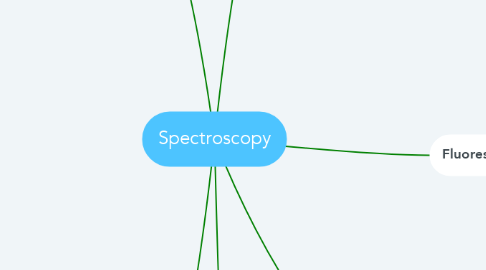
1. UV-Vis
1.1. Basics
1.1.1. UV-Vis range: ~1-800nm
1.1.2. Types of electrons: Shared (forming sigma or pi bonds) Unshared, localized
1.1.3. Wavelength absorption: For single bonds, <180nm For double/triple bonds, >180nm For unshared electrons, >180nm
1.2. General setup: Source-monochromator-sample/blank-detector-signal processor
1.3. Light source types: UV: Deuterium, hydrogen Vis: Tungsten, Xenon
1.4. Sample cells: UV: quartz or fused silica Vis: glass or plastic
1.5. Beer's Law deviations: 1. High concentration resulting in the neighbor effect 2. Polychromatic radiation - mixing of different wavelengths 3. Apparent chemical deviations - differential ionization with concentration 4. Stray radiation - makes concentration appear higher
1.6. Uses: Characterization Quantitative analysis Kinetic measurement
2. Atomic
2.1. Classifications
2.1.1. Atomic absorption
2.1.1.1. General setup Source-sample (atomized)-wavelength selector-detector-amplifier-readout
2.1.1.2. Qualities: Easier to use, low maintenance, low consumables, measures one element at a time
2.1.1.3. Sample introduction/atomization: Acidified sample is nebulized and then atomized via flame (or graphite furnace)
2.1.1.4. For flame, 1% or better precision, 10^-4 s residence time For graphite furnace, excellent LOD, more sensitive than flame, entire sample atomized at once, and residence time in optical path >1s
2.1.1.5. Present/potential issues: For flames: recombination readily in flame, ionization by too strong a flame, short optical path For graphite furnace, narrow analytical range and poor precision
2.1.2. Atomic emission
2.1.2.1. General setup: Source and atomized sample-wavelength selector-detector-readout
2.1.2.2. Qualities: Less potential to have chemical interference, qualitative and quantitative measurements, many elements measured at the same time
2.1.2.3. Effect of temperature: Increase in temperature increases atomization efficiency, line broadening, decreases peak height
2.1.3. Atomic fluorescence
2.1.4. X-ray fluorescence
2.2. Line broadening
2.2.1. Heisenberg uncertainty principle - depends on lifetime of excited state; very narrow (10^-4 Angstroms)
2.2.2. Doppler broadening - line widths of 10^-2 Angstroms
2.2.3. Pressure (Lorentz) broadening - collision with other atoms
3. Fluorescence
3.1. Radiative emission of a photon
3.2. Excitation at a lower wavelength and emission at a higher wavelength
3.3. Quantum Yield: photons out/photons in
3.4. Non-radiative emission
3.4.1. Internal conversion: Relaxation between lowest vibrational level of the excited state to uppermost vibrational level of a lower state
3.4.2. Vibrational relaxation: Energy loss by movement of energy to a lower vibrational level in the same electronic state Solvent and temperature dependent
3.5. Impacts on fluorescence
3.5.1. Best fluorescence occurs when fused rings, conjugation, cooler temperature, heavy atom solvents, and lower presence of oxygen occurs
3.5.2. Quenching: Absorption of emitted energy
4. Basics
4.1. Spectroscopy: interaction off all types of radiation with matter
4.2. Types of Radiation
4.2.1. Electromagnetic radiation: Visible, infrared, gamma, x-ray, microwave, radiowave
4.2.2. Non-electromagnetic radiation: Acoustic waves or beams of particles (ions or electrons)
4.3. Types of Interactions: Absorption, emission, scattering, reflection, refraction, dispersion, interference, diffraction, polarization
4.3.1. Polarization
4.3.1.1. Polarized: light waves travelling perpendicular to each other
4.3.2. Refraction
4.3.2.1. Light travelling through a medium
4.3.3. Reflection
4.3.3.1. Occurs when light crosses an interface between media of differing refractive indices
4.3.4. Interference
4.3.4.1. Waves of the same frequency interact
4.3.4.1.1. Constructive interference: Waves in phase add together, increasing amplitude
4.3.4.1.2. Destructive interference: Waves out of phase disrupt each other, decreasing amplitude
